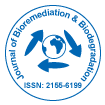Innovative Approaches in Biodegradation and Bioremediation of Pollutants: Applications and Emerging Technologies
Received Date: Nov 01, 2024 / Published Date: Nov 30, 2024
Abstract
The increasing levels of environmental pollutants, including industrial chemicals, heavy metals, pesticides, and hydrocarbons, pose significant threats to ecosystems and human health. Traditional methods of pollution control, such as chemical treatments and physical removal, often face limitations related to cost, efficiency, and environmental impact. As a result, biodegradation and bioremediation have emerged as promising, sustainable alternatives for the mitigation of environmental pollution. These biological processes utilize microorganisms, plants, or their enzymes to break down or transform harmful contaminants into less toxic forms. Recent advancements in bioremediation technologies, including genetically engineered microorganisms (GEMs), microbial consortia, phytoremediation, and nanotechnology, offer innovative solutions to tackle complex pollutants in diverse environments. This review explores novel strategies and applications of biodegradation and bioremediation, highlighting the mechanisms involved, emerging technologies, and challenges in implementing these approaches on a larger scale. The article also discusses the future perspectives of bioremediation, emphasizing the need for integrated approaches that combine biological, chemical, and physical methods for enhanced pollutant removal.
Share This Article
Recommended Journals
Open Access Journals
Article Tools
Article Usage
- Total views: 279
- [From(publication date): 0-0 - Apr 04, 2025]
- Breakdown by view type
- HTML page views: 124
- PDF downloads: 155
